Have you ever wondered how you can monitor your entire Linux system performance easily?
What if you wanted to monitor your filesystems, disks, CPUs, but also your network statistics, similarly to what you would do with netstat?
What if you had a complete dashboard detailing every single metric on your system easily?
If you are looking for all those features, you are in the right tutorial.
Today we are taking a very special look at the Node Exporter, a Prometheus exporter specialized in exposing Linux metrics right off the bat.
If you are new to Prometheus, I would recommend that you read my complete guide to Prometheus.
It will help you understanding the basics of this awesome time series database.
Now that you have some basics about Prometheus, let’s build our entire Linux monitoring system.
Ready?
What You Will Learn
Before starting a complete tutorial, let’s have a look at all the different topics that you are going to learn today.
- Existing ways to monitor your linux system: you will learn about the free and paid tools that you can use in order to quickly monitor your infrastructure
- What is the Node Exporter and how to properly install it as a service
- Bind your Node Exporter with Prometheus and start gathering system metrics
- Play with prebuilt Grafana dashboards to build 100+ panels in one click
At the end of this tutorial, you will be able to build your own monitoring infrastructure and add many more exporters to to it.
I – Linux Monitoring Basics
Before building our entire monitoring architecture, let’s have a look at what are the current existing solutions and what problems we are trying to solve with the Node Exporter.
a – Existing solutions
As a system administrator, there are multiple ways for you to monitor your Linux infrastructure.
- Command line tools
There are plenty of command line tools for you to monitor your system.
They are very known to every system administrator and are often very useful to perform some simple troubleshooting on your instance.
Some examples of command line tools may be top or htop for the CPU usage, df or du for the disks or even tcpdump for an easy network traffic analysis.
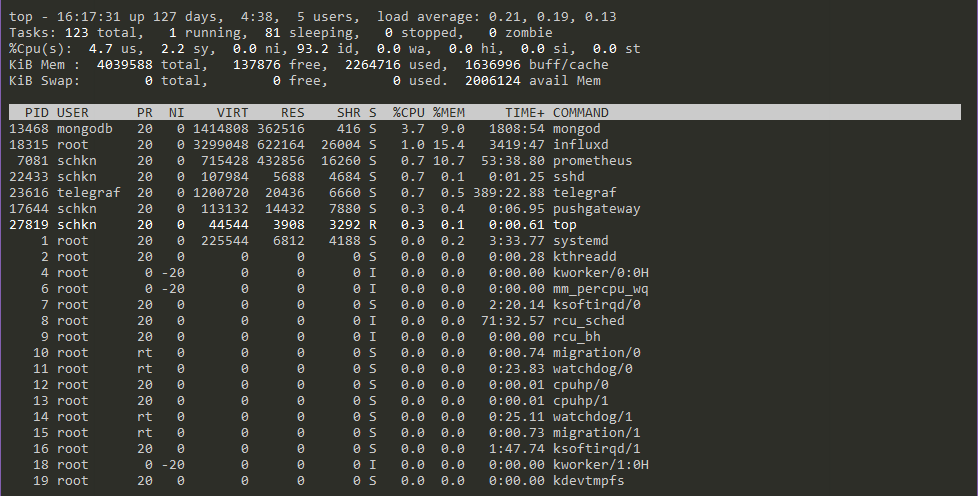
Those solutions are great but they have major downsides.
Besides being very easy to use, they are often formatted in different ways, making it hard to export them in a consistent way.
Also, to run those commands, you sometimes need elevated privileges on the system which is not always the case.
With a complete monitoring system, you can have the security rules handled directly in your dashboarding system (for example Grafana) and you don’t need to provide direct access to your instance to whoever wants to troubleshoot outages.
- Desktop solutions
Desktop solutions provide a more consistent and probably a more practical solution to system monitoring.
Some examples of those tools are the very established SolarWinds Linux Performance Monitoring Tool (that provides very complete dashboards for your Linux system) or Zabbix with the Metric Collection product.

The Linux Performance Monitoring Tools by SolarWinds is a paid tool, but if you want a solution ready to use very quickly, they are a great opportunity for your Linux monitoring.
b – Node Exporter & Prometheus
Now that we know what the existing tools for linux monitoring are, let’s have a look at what we are going to use today : the node exporter and Prometheus.
As stated before, Prometheus scrapes targets and the node exporter is just one of them.
In your architecture, you will have the following components:
- A time series database, in this case Prometheus made to store the different metrics retrieved by the node exporter
- A Node Exporter run as a systemd service that will periodically (every 1 second) gather all the metrics of your system.
- A dashboard solution, in this case Grafana, displaying metrics gathered from Prometheus. We are not going to build every single panel by ourselves. Instead, we are going to use a very powerful feature of Grafana which is the dashboard import. (as a reminder, Grafana has a list of hundreds of dashboards that you import within the UI)
In our case, the whole stack will be run within the same instance, so there will be no needs to configure any firewall rules.
The node exporter will run on the port 9100 and Prometheus will run on the port 9090
Note : as part of the configuration, Prometheus can actually monitor itself.
Now that you have an idea of what a monitoring architecture looks like, let’s install the different tools needed.
II – Installing the Tools Needed
As a reminder, for our architecture, we are going to need Prometheus, the Node Exporter and Grafana.
This tutorial focuses on installing the node exporter completely, but there’s also a quick installation for other tools.
a – Installing the Node Exporter
Before installing Prometheus, we need to install the Node Exporter as a service.
Head to https://prometheus.io/download/ and download the latest binary for the node exporter (here 0.18.1)
$ wget https://github.com/prometheus/node_exporter/releases/download/v0.18.1/node_exporter-0.18.1.linux-amd64.tar.gzThe archive contains a single binary which is node_exporter.
This is the binary we are going to launch to start gathering metrics on our system.
Now that you have the archive, extract it, and inspect the content of it.
$ tar xvzf node_exporter-0.18.1.linux-amd64.tar.gzNow to install it as a service, here are the instructions:
- Create a node exporter user
$ sudo useradd -rs /bin/false node_exporter- Copy the binary to your /usr/local/bin folder.
$ cp node_exporter-0.18.1.linux-amd64/node_exporter /usr/local/bin- Apply the correct permissions to your binary file.
$ chown node_exporter:node_exporter /usr/local/bin/node_exporterNote : you will need to have a node_exporter user to run the binary.
- Navigate to /etc/systemd/system and create a new service file
$ cd /etc/systemd/systemd
$ sudo vim node_exporter.serviceThen, paste the following configuration for your service.
[Unit]
Description=Node Exporter
After=network-online.target
[Service]
User=node_exporter
Group=node_exporter
Type=simple
ExecStart=/usr/local/bin/node_exporter
[Install]
WantedBy=multi-user.target- Exit vi, reload your daemon, and start your service.
$ sudo systemctl daemon-reload
$ sudo systemctl start node_exporter- Check your service by running the following command
$ sudo systemctl status node_exporter.serviceIs your service running correctly?
- Enable your service for system startup
$ sudo systemctl enable node_exporter- Verify that your node exporter is correctly up and running with a simple curl command
$ curl http://localhost:9100/metricsCan you see the key-value pairs metrics of your system metrics?
We are done with the Node Exporter installation!
b – Installing Prometheus
It is not the first time we install Prometheus for our projects.
First, head over to https://prometheus.io/download/ and run a simple wget command to get the latest binaries.
$ wget https://github.com/prometheus/prometheus/releases/download/v2.10.0/prometheus-2.10.0.linux-amd64.tar.gzFor this tutorial, we are running the 2.10.0 version from May 2019.
You should now have an archive, extract it, and navigate inside the folder.
# tar xvzf prometheus-2.10.0.linux-amd64.tar.gz
# cd prometheus-2.10.0.linux-amd64/ Inside this folder, you have multiple elements:
- prometheus: the executable file that launches a Prometheus server;
- prometheus.yml: the configuration file for your Prometheus server;
- promtool: a tool that can be used to check your Prometheus configuration.
In our case, we are first going to modify the prometheus configuration file.
Navigate in it with vi:
# vi prometheus.ymlThen perform the following modifications:
global:
scrape_interval: 1s # Set the scrape interval to every 1 second.As a reminder, Prometheus scrapes targets. In our case, we want it to scrape our system metrics every one second.
Then, in the “scrape_configs” section, under the “static_configs” section, add the following lines.
static_configs:
- targets: ['localhost:9090', 'localhost:9100']It means that Prometheus will scrape the node exporter metrics, as well as its own metrics.
For now, simply launch Prometheus as a background process, and verify that it is correctly launched by pinging the Web UI interface.
> ./prometheus &
Can you see the web console?
We are done with the Prometheus setup!
c – Installing Grafana
The last part of our initialization section is about installing Grafana.
As a reminder, Grafana is an open source dashboard monitoring solution that binds to databases in order to display metrics in a variety of ways.

To install Grafana, head over to https://grafana.com/grafana/download and download the latest binaries available for you.
$ wget https://dl.grafana.com/oss/release/grafana_6.2.4_amd64.debFor this tutorial, we are using the 6.2.4 version of Grafana that includes the new bar gauges.
Extract the .deb file and Grafana should automatically start as a service on your computer.
$ sudo dpkg -i grafana_6.2.4_amd64.deb You can verify that Grafana is running with the following command:
$ sudo systemctl status grafana-server
● grafana-server.service - Grafana instance
Loaded: loaded (/usr/lib/systemd/system/grafana-server.service; disabled; vendor preset: enabled)
Active: active (running) since Thu 2019-06-22 10:43:12 UTC; 5 days ago
Docs: http://docs.grafana.orgIf the status is set to Active, and if no visible errors are shown in your console, then Grafana is now installed correctly on your machine.
By default, Grafana is running on port 3000, and the default credentials are
- username: admin
- password: admin
You will be asked to change them immediately on the first connection.
With a web browser, head over to http://localhost:3000, and follow the instructions until you see the welcome screen.

As described in the screenshot, click on ‘Add data source‘ and create a new Prometheus datasource.
As described in our other tutorials, you can configure your datasource with the following configuration:
Note: if you configured your Prometheus instance to run on another port, you have to change it in the configuration.
III – Building a complete Grafana dashboard for the Node Exporter
Now that all your tools are set, there is not much work to do in order to have our dashboards.
For this, we are not going to build our dashboards by ourselves. Instead, we are going to use the “Import dashboard” feature of Grafana.
In the top left menu, hover your mouse over the “Plus” icon and click on the “Import” element in the dropdown list.
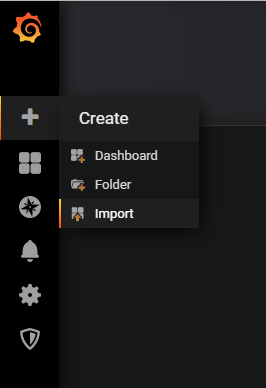
You will be presented with the following window:
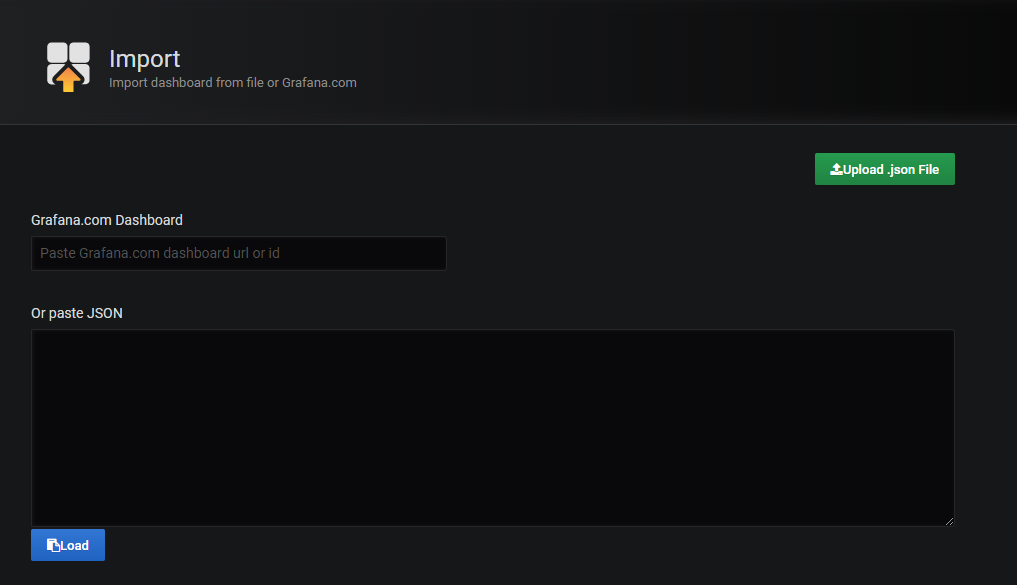
In this window, you have multiple choices. You can either:
- Type a dashboard URL or ID and it will be automatically imported in your Grafana instance.
- Upload a JSON file (as a quick reminder, Grafana dashboards are exported as JSON files and can be easily shared this way)
- Paste directly the raw JSON
In our case, we are going to use the first option by typing the dashboard id directly in the text field.
b – Getting Inspiration for Dashboards
We don’t have to build the dashboards all by ourselves.
This is especially true when you have dozens of metrics to look for.
You would have to spend a lot of time understanding the different metrics and building panels out of them.
We are going to use Grafana Dashboards for this. Grafana Dashboards is a repository owned by Grafana that stores hundreds of dashboards for you to choose from.
In our case, we are going to focus on Node Exporter dashboards.
Type “Node Exporter” in the search box and scroll until you reach the “Node Exporter Full” dashboard.

As you probably noticed it, the dashboard has the ID 1860 (the information is available into the URL of the website).
This is the ID that we are going to copy in order to monitor our system.
In the import, type “1860” in the Grafana.com dashboard text field, and hit “Load”.
You will be presented with a second screen to configure your dashboard.
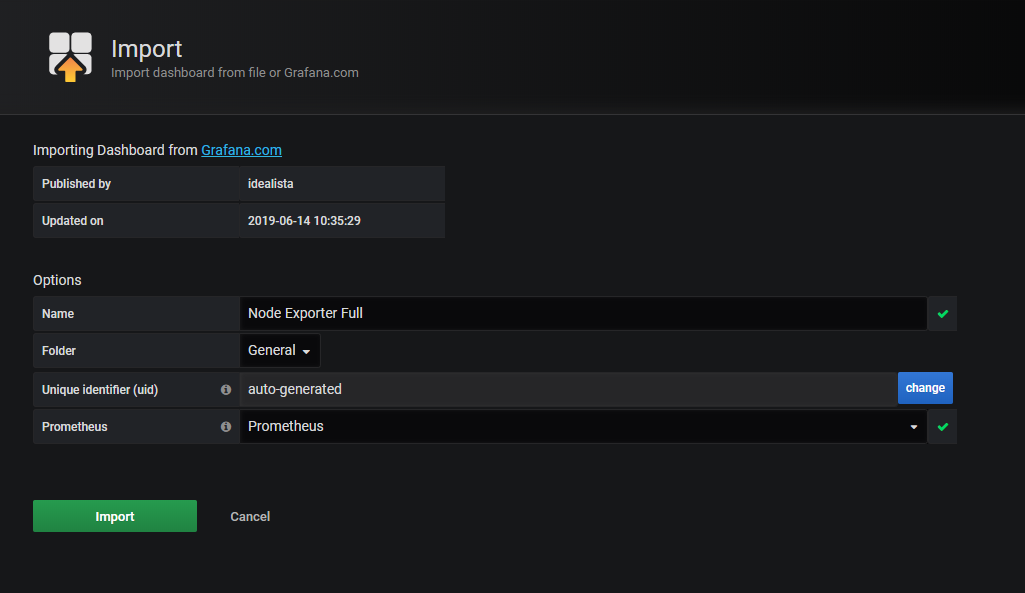
Every field is filled automatically.
However, you will have to select the datasource, in my case “Prometheus“. (you have to link it to the datasource you created in section 2)
Hit “Import” when you are done.
In under a second, all the different panels will be built for you!
That’s 29 categories with over 192 panels created automatically. Awesome.
Here are some examples of how the dashboards looks:
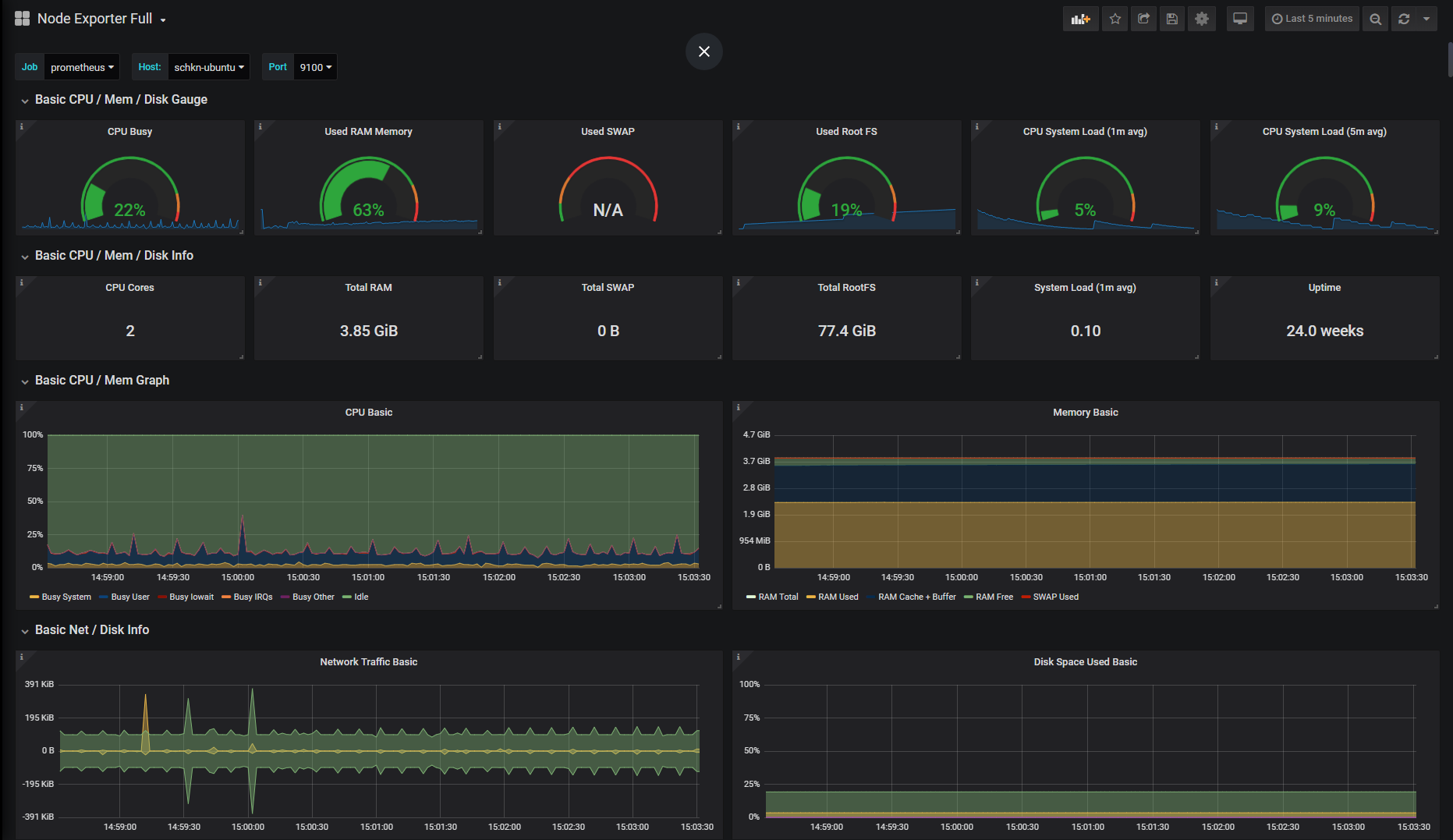
You can also have a look at all the options available in this whole panel.
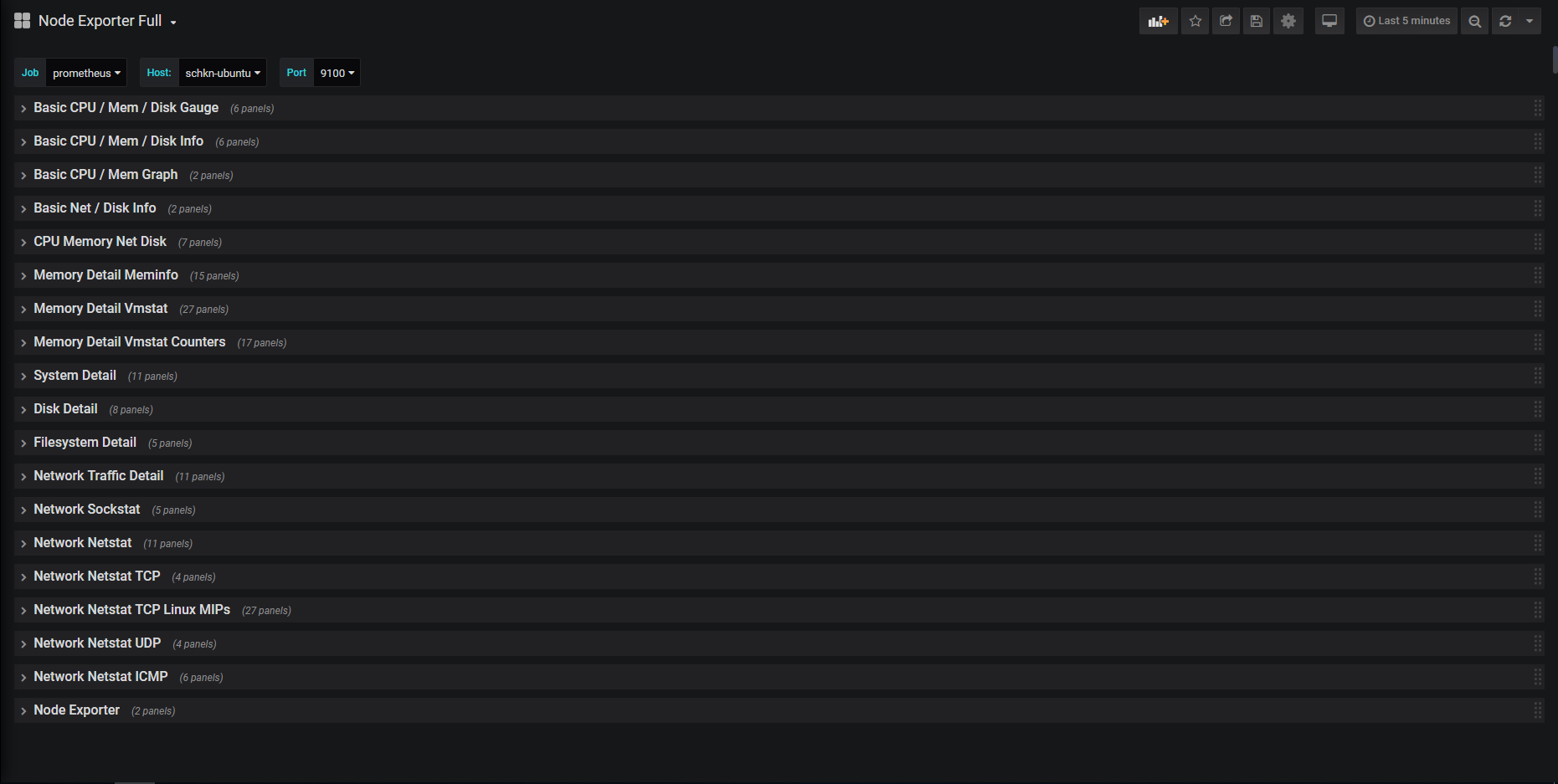
IV – Going Further
Mastering the Node Exporter is definitely a must have skill for engineers willing to get started with Prometheus.
However, you can dig a little bit deeper using the Node Exporter.
a – Additional Modules
Not all modules are enabled by default, and if you run a simple node exporter installation, chances are that you are not running any additional plugins.
Here’s the list of the additional modules:
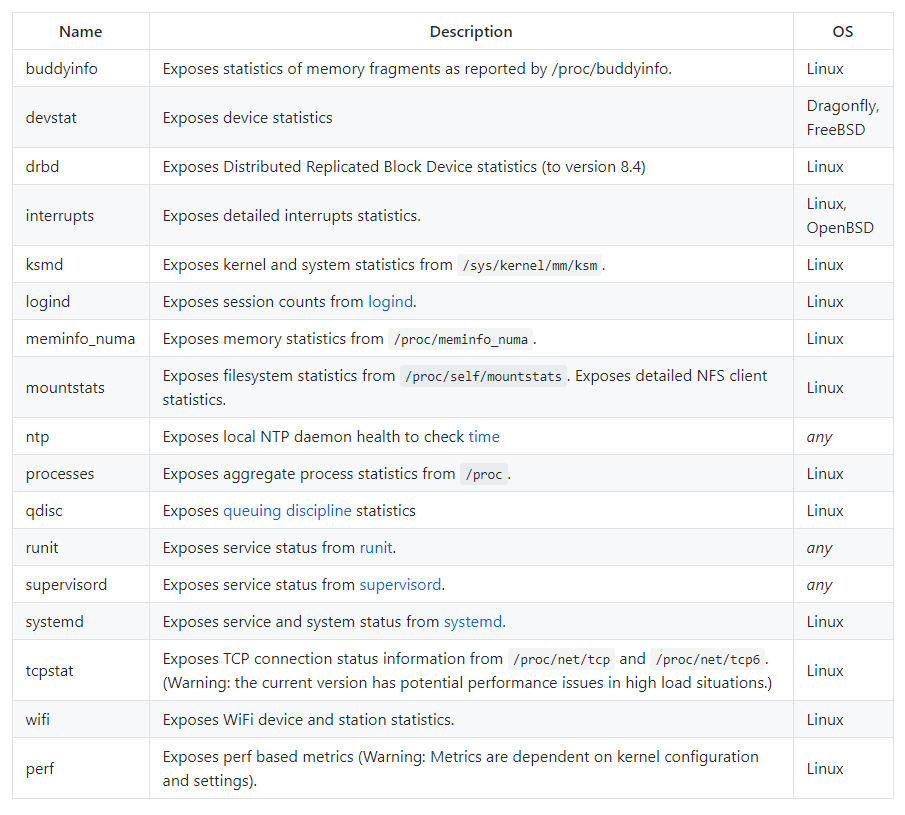
In order to activate them, simply add a –collector.<name> flag when running the node exporter, for example:
ExecStart=/usr/local/bin/node_exporter --collector.processes --collector.ntpThis should activate the processes and the ntp collectors.
b – TextFile Collector
A complete Node Exporter guide would not be complete without talking about the TextFile collector, at least for a small section.
Similarly to the Pushgateway, the textfile collector collects metrics from text files and stores them right into Prometheus.
It is designed for batch jobs or short-lived jobs that don’t expose metrics in a continuous way.
Some examples of the textfile collector are available here:
- Using the text file collector from a shell script.
- Monitoring directory sizes with the textfile collector.
c – Videos Resources
Finally, I like to link to external videos that are closely related to the subject or particularly interesting.


7 comments
[…] Complete Node Exporter Mastery with Prometheus […]
Excellent, if you can share some use case for Kubernetes deployment using Prometheus and pod monitoring with Alert
I usually read blogs like this and I never comment, but this one was so well done, I had to comment to say Thank you! So, Thank you! Very well written.
Thanks alot for sharing this info!
Muito boa explicação.
Hi, tnx a lot for sharing….this line need to be corrected:
$ cd /etc/systemd/systemd—->$cd /etc/systemd/system
How do we customize the node exporter metrics?